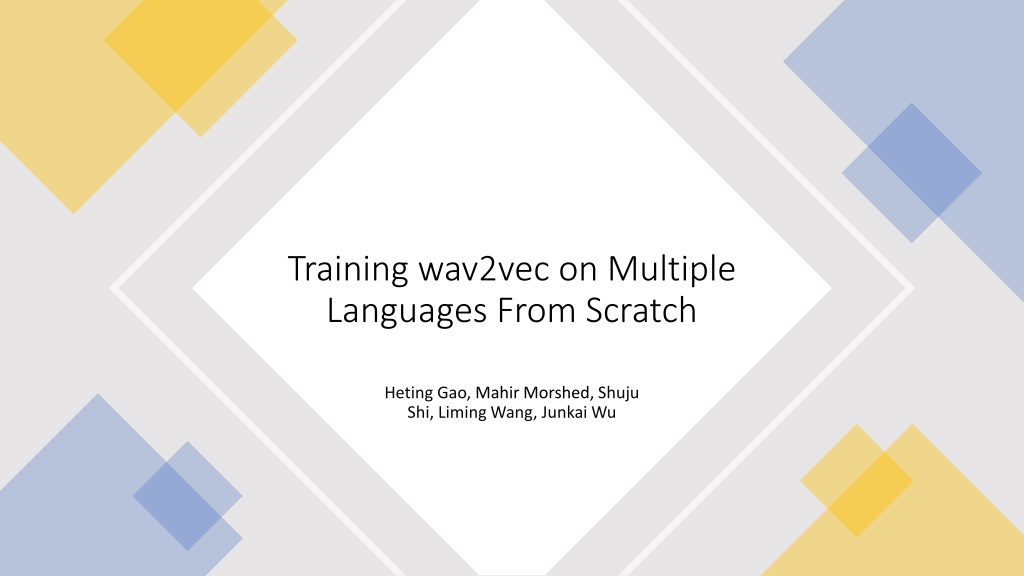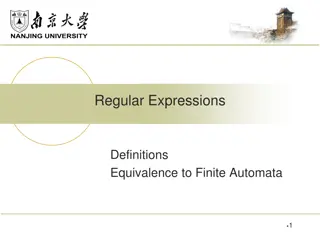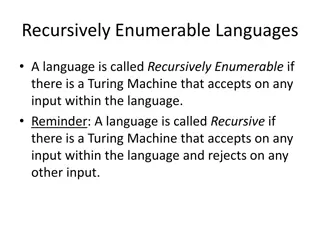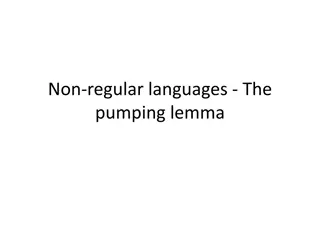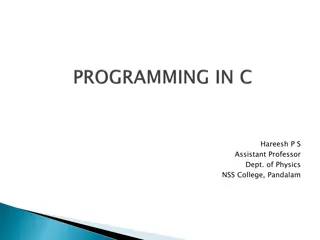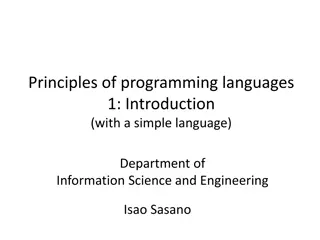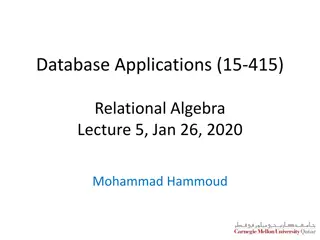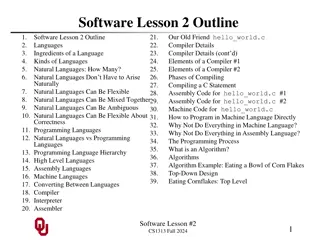Training wav2vec on Multiple Languages From Scratch
Large amount of parallel speech-text data is not available in most languages, leading to the development of wav2vec for ASR systems. The training process involves self-supervised pretraining and low-resource finetuning. The model architecture includes a multi-layer convolutional feature encoder, quantization module, Transformer encoder, and additional linear layers for finetuning. Previous works on wav2vec and objectives of wav2vec with different languages are discussed, along with datasets considered for training.
Download Presentation

Please find below an Image/Link to download the presentation.
The content on the website is provided AS IS for your information and personal use only. It may not be sold, licensed, or shared on other websites without obtaining consent from the author.If you encounter any issues during the download, it is possible that the publisher has removed the file from their server.
You are allowed to download the files provided on this website for personal or commercial use, subject to the condition that they are used lawfully. All files are the property of their respective owners.
The content on the website is provided AS IS for your information and personal use only. It may not be sold, licensed, or shared on other websites without obtaining consent from the author.
E N D
Presentation Transcript
Training wav2vec on Multiple Languages From Scratch Heting Gao, Mahir Morshed, Shuju Shi, Liming Wang, Junkai Wu
Introduction Large amount of parallel speech-text data not available in most languages wav2vec: a new paradigm of training an ASR system by splitting the training process into two stages: Self-supervised pretraining (only unlabeled audio is required) Low-resource finetuning (small amount of parallel speech-text data is required)
Introduction Model Architecture Multi-layer convolutional feature encoder Quantization module to discretize the features into codewords in a codebook Transformer encoder to output contextual representation of each frame Pretraining to predict the codeword of the current frame using content representation Contrastive loss with negative sampling Codebook diversity loss Finetuning Additional linear layers and CTC loss Freeze the pretrained wav2vec and finetune only the linear layers
Introduction Previous works: wav2vec 2.0 only trained the model on English XLSR-53 trained a multilingual wav2vec on a 53-language dataset Multilingual wav2vec has a better cross-lingual performance VoxPopuli released a large-scale multilingual speech corpus 23 languages of the European Union of which 16 partially have transcriptions Pretrained wav2vec models provided Objectives: How does wav2vec work with other languages (such as Asian languages)? How does a wav2vec pretrained on different languages affect performance? doi:10.48550/arXiv.2006.11477 doi:10.48550/arXiv.2006.13979 doi:10.18653/v1/2021.acl-long.80
Datasets considered (chosen languages highlighted) Multilingual LibriVox English (en) (36000 h), German (1691 h), Dutch (1264 h), French (897 h), Spanish (735 h), Italian (220 h), Portuguese (136 h), Polish (91 h) LibriLight for English (ft-en) (10h used) LaboroTVSpeech for Japanese (ja) (2000 h) Corpus of Spontaneous Japanese (ft-ja) (661 h) Babel (200 h per language) Bengali, Vietnamese, Zulu, Amharic, Javanese, Georgian, Cantonese, Lao GlobalPhone (20 h per language) Czech, French, Mandarin (ft-zh), Thai, German, Portuguese, Turkish, Bulgarian (ft-bg), Croatian, Spanish, Polish OpenSLR (all but the last two from Google) Javanese (295 h), Sundanese (332 h), Sinhala (225), Bengali (215 h), Nepali (154 h), Korean (51 h), Kazakh (332 h) Europarl-ST English (637 h), French (176 h), German (153 h), Italian (181 h), Spanish (116 h), Portuguese (82 h), Polish (151 h), Romanian (108 h), Dutch (38 h) United Nations Proceedings Speech (~1000h per language) English, Mandarin (zh), Standard Arabic (ar), French, Russian (ru), Spanish Common Voice Kinyarwanda (2000 h), Esperanto (1300 h), Catalan (1200 h), Belarusian (1000 h) VoxPopuli (2.7k to 24.1k h) English, German, French, Spanish, Polish, Italian, Romanian, Hungarian, Czech, Dutch, Finnish, Croatian, Slovak, Slovene, Estonian, Lithuanian, Portuguese, Bulgarian (bg), Greek, Latvian, Maltese, Swedish, Danish GALE Broadcast News Datasets for Standard Arabic (ft-ar) (~120 h for Phase 3 Part 2) Russian (ft-ru) LibriSpeech (~100 h)
Experiment (English Baseline) Hardware NCSA's HAL cluster 4 x 16 GB NVIDIA V100 GPU wav2vec model settings wav2vec base model has max token per batch: 1M (originally was 1.4M) XLSR-53 model has max token per batch: 600k (originally was 1.28M) Update frequency is 16 to simulate 64 GPU training (2 weeks) English baseline Better performance (unit error rate) when finetuned on English Slightly worse performance when finetuned on Bulgarian Validation UER Validation WER Test UER official-en-ft-en - 10.9 - en-ft-en 3.51 9.87 2.97 official-en-ft-bg 3.34 17.37 3.31 en-ft-bg 3.48 17.68 3.47
Experiment (Mono- vs Cross- vs Multi-lingual) Three settings Monolingual finetuning Cross-lingual finetuning (English) Multilingual finetuning (XLSR-53) Monolingual finetuning > Multilingual finetuning > Cross-lingual finetuning English and Russian excepted Multi Valid UER Valid WER Test UER Mono Train Loss Valid UER Valid WER Test UER Cross Valid UER Valid WER Test UER en-ft-en 0.07 3.51 9.87 2.97 xlsr-ft-en 1.91 6.58 1.91 en-ft-en 3.51 9.87 2.97 bg-ft-bg 1.53 1.85 8.78 1.89 xlsr-ft-bg 2.67 13.79 2.70 en-ft-bg 3.48 17.68 3.47 zh-ft-zh 2.00 10.43 - 10.60 xlsr-ft-zh 14.15 - 14.56 en-ft-zh 15.20 - 15.41 ru-ft-ru 1.95 5.57 23.06 6.98 xlsr-ft-ru 5.84 28.21 4.84 en-ft-ru 5.57 27.92 5.59 ar-ft-ar 1.77 3.62 12.32 3.45 xlsr-ft-ar 4.67 17.56 4.58 en-ft-ar 6.49 20.41 5.47 jp-ft-jp 1.98 10.38 - 9.91 xlsr-ft-jp 14.67 - 14.35 en-ft-jp 16.08 - 16.33
Experiment (Grapheme vs IPA) Convert graphemes into International Phonetic Alphabet (IPA) using LanguageNet Grapheme-to- Phoneme Transducers (g2ps) Expected IPA transcripts to have lower error rates Turns out not to be the case generally Bulgarian and Mandarin have much lower error rates using graphemes English, Russian and Arabic have slightly lower error rates using graphemes Japanese has much lower error rate using IPA Multi Test UER Test UER IPA Cross Test UER Test UER IPA Mono Test UER Test UER IPA en-ft-en 2.97 3.19 xlsr-ft-en 1.91 2.29 en-ft-en 2.97 3.20 bg-ft-bg 1.89 11.28 xlsr-ft-bg 2.70 17.38 en-ft-bg 3.47 14.86 zh-ft-zh 10.60 15.03 xlsr-ft-zh 14.56 16.10 en-ft-zh 15.41 18.05 ru-ft-ru 6.98 7.87 xlsr-ft-ru 4.84 5.26 en-ft-ru 5.59 6.10 ar-ft-ar 3.45 4.20 xlsr-ft-ar 4.58 5.24 en-ft-ar 5.47 6.55 jp-ft-jp 9.91 3.32 xlsr-ft-jp 14.35 4.51 en-ft-jp 16.33 4.98
Experiment (Mandarin) Extra experiments on Mandarin Chinese Chinese characters IPA with or without tone Pinyin with or without tone Converting to Pinyin phonemes can greatly reduce the error rate g2ps probably contain errors when transducing from Chinese characters to IPA wav2vec can capture tone information very well zh-ft-zh Test UER en-ft-zh Test UER xlsr-ft-zh Test UER char 10.60 char 15.41 char 14.56 IPA 15.03 IPA 18.05 IPA 16.10 IPA w/o tone 14.56 IPA w/o tone 16.94 IPA w/o tone 15.44 Pinyin 2.96 Pinyin 3.80 Pinyin 4.02 Pinyin w/o tone 2.31 Pinyin w/o tone 2.97 Pinyin w/o tone 2.79
Experiment (Japanese Kana) Extra experiments on Japanese Kana Use wav2vec pretrained on Japanese, English, Mandarin Chinese, Spanish and XLSR-53 Finetune on Japanese Cross-lingually, English > Spanish > Mandarin Chinese Multilingual XLSR-53 is better than the cross-lingual models. Kana Test UER jp-ft-jp 5.08 en-ft-jp 8.18 es-ft-jp 8.60 zh-ft-jp 9.66 xlsr-ft-jp 7.16
